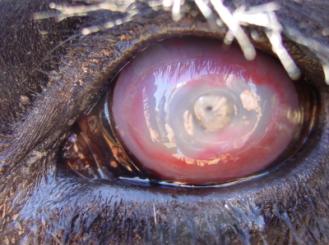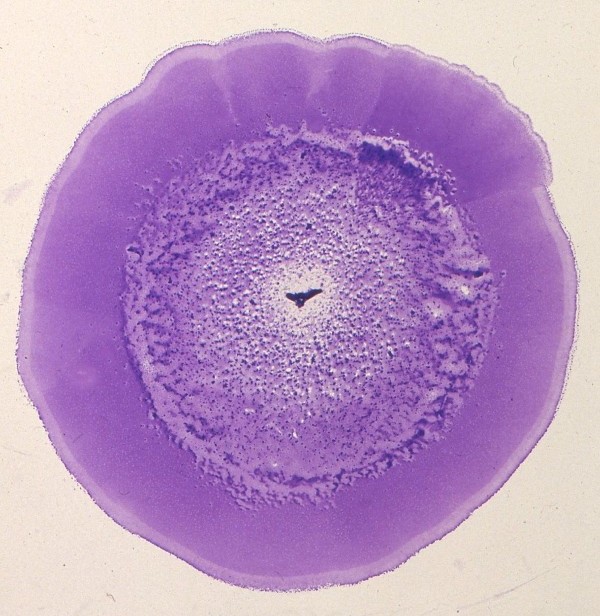Moraxella bovis
A Microbial Biorealm page on the genus Moraxella bovis
Classification
Higher order taxa
Bacteria; Proteobacteria; Gammaproteobacteria; Pseudomonadales; Moraxellaceae, Moraxella (2). http://www.ncbi.nlm.nih.gov/Taxonomy/Browser/wwwtax.cgi?id=476
Species

Moraxella bovis
Description and significance
Moraxella bovis is a highly opportunistic bacterium infecting cattle herds worldwide, causing Infectious Bovine Keratoconjunctivits (IBK), also known as pinkeye or ‘New Forest Eye’. This disease is characterized by inflammation and ulceration of the conjunctiva causing discomfort, excessive tearing (4) and can eventually cause ocular rupturing. This bacterium thrives on the surface of cattle eyes proliferating exponentially in the presence of oxygen and ultraviolet rays from the summer sun, which predisposes the eye to infection (4,9). IBK is transferred from cattle to cattle with flies acting as virulent vectors (5), tall blades of grass while cattle graze (7) and direct contact. Increased rates of infection occur during the summer and fall season as there is a correlation with increased sunlight and fly populations.
Genome structure
Contiguous DNA size is 15826 bp, contigs N50 (4). M. bovis has circular DNA. The DNA genome sequence of the bacterial strain Moraxella bovis Epp63 has been or is still being determined with 361 contigs read using Sanger method analysis (3).
Cell and colony structure
Moraxella bovis is a gram-negative coccobacillus, non-motile, free-living bacteria measuring between 0.6 – 1.0 µm in diameter (2,4,8), lacking flagella with varying amounts of pili. M. bovis is able to use colonial morphology (5) as a way to adapt to environmental changes. Colonies can switch between spreading-corroding (SC) and non-corroding (N) morphologies. The more virulent and common colony type is that of the SC form, which grows in flat cylindrical disk a few bacteria thick (5). Studies show that by puncturing the agar during planting allows the bacteria to adapt and grow on the interface between the Petri dish and the agar (5). Depending on the M. bovis parental cells, colony shapes thickness and dispersion differs relative to the speed of growth.

Metabolism
Being an aerobic pathogen, M. bovis uses environmentally available glucose as fuel, as well as importing essential enzymes, and uses oxygen as its electron acceptor at the end of the electron transport chain (2,8). Studies have shown that to support growth, Moraxella bovis isolates can bind bovine lactoferrin and bovine transferrin and use these proteins as a source of iron (10).
Ecology
Habitat; symbiosis; contributions to the environment. metagenomic data link
Pathology
How does this organism cause disease? Human, animal, plant hosts? Virulence factors.
References
1. Angelos, John A., V. Michael Lane, Louise M. Ball, and John F. Hess. "Recombinant Moraxella Bovoculi Cytotoxin-ISCOM Matrix Adjuvanted Vaccine to Prevent Naturally Occurring Infectious Bovine Keratoconjunctivitis." Veterinary Research Communications 34.3 (2010): 229-39. Print. doi: 10.1007/s11259-010-9347-8 . http://www.ncbi.nlm.nih.gov/pmc/articles/PMC2855018/
2. Bergey, D. H., Noel R. Krieg, and John G. Holt. Bergey's Manual of Systematic Bacteriology. Baltimore, MD: Williams & Wilkins, 1984. Pp 415. http://books.google.com/books?id=0-VqgLiCPFcC&q=moraxella+bovis#v=onepage&q=moraxella&f=false
3. "Genes and Mapped Phenotypes." National Center for Biotechnology Information. U.S. National Library of Medicine. Web. 19 Mar. 2012. http://www.ncbi.nlm.nih.gov/gene
4. Highlander, Sarah K., and George M. Weinstock. "HGSC at Baylor College of Medicine." HGSC at Baylor College of Medicine. 27 June 2006. Web. 19 Mar. 2012. http://www.hgsc.bcm.tmc.edu/projects/microbial/microbial-detail.xsp?project_id=123 .
5. McMichael, J. C. "Bacterial Differentiation within Moraxella Bovis Colonies Growing at the Interface of the Agar Medium with the Petri Dish." Microbiology 138.12 (1992): 2687-695. NCBI. Web. 07 Feb. 2012. doi: 10.1099/00221287-138-12-2687 . http://www.ncbi.nlm.nih.gov/pubmed/1362585
6. McMichael, John C. Moraxella Bovis – Evolution in a Petri Dish. Photograph. http://pandasthumb.org/archives/2009/11/moraxella-bovis.html . 30 Nov. 2009.
7. R, Craig. New Forest Eye. 2011. Photograph. http://informedfarmers.com/new-forest-eye-in-beef-cattle/
8. Rodriguez, Jose E., Abebe Hassen, and James Reecy. "Infectious Bovine Keratoconjunctivitis (Pinkeye) Study." Iowa State University, McNay Memorial Research and Demonstration Farm. Web. www.ag.iastate.edu/farms/05reports/.../InfectiousBovineKeratocon.pdf
9. Schaechter, Moselio, John L. Ingraham, and Frederick C. Neidhardt. Microbe. Washington, D.C.: American Society for Microbiology, 2006.
10. Yu, R. H., and A. B. Schryvers. "Bacterial Lactoferrin Receptors: Insights from Characterizing the Moraxella Bovis Receptors." PubMed 80.1 (2002): 81-90. Web. http://www.ncbi.nlm.nih.gov/pubmed/11908647 .
